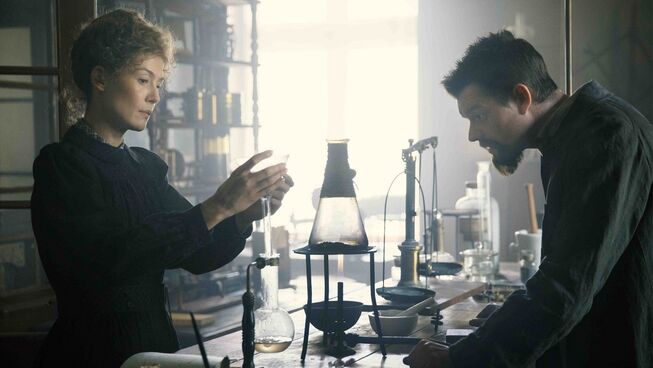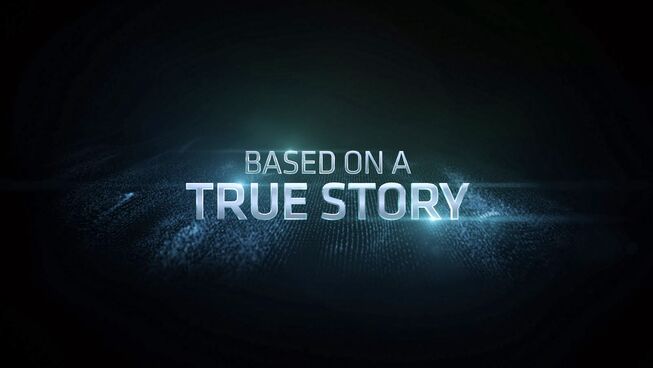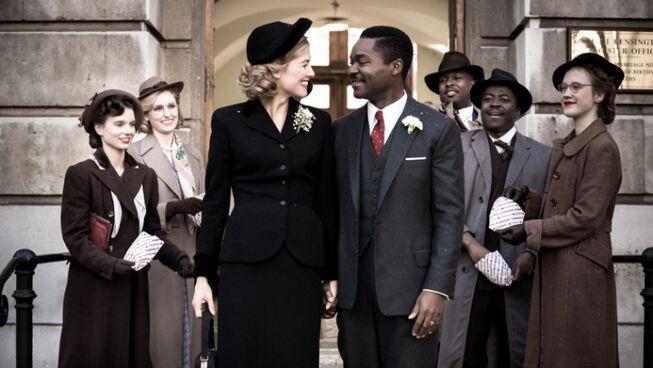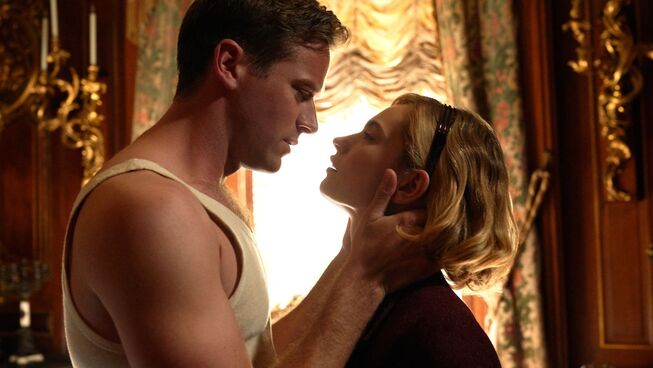
2.5 out 5 stars
Every generation currently living on earth will know something about or have been impacted by the effects of radioactivity. On the positive side, it has provided humanity with x-ray machines, remedies for cancer and a controversial means of energy. Along with these positive attributes comes a dark side to this discovery which has led to the invention of atomic weapons and nuclear waste. Yet, this scientific discovery was one that changed history unlike anything else during the turn of the century and made the names of Pierre and Marie Curie a permanent fixture in world history.
In the late 1800s, women were not taken seriously in the fields of physics and chemistry. Maria Skłodowska (Rosemund Pike) had a multitude of challenges before her that went beyond being a woman. She was Polish while living in Paris and her personality was not going to win her any popularity contests. Which meant she struggled to get a laboratory to do her experiments and unleash the scientific discoveries that manifested in her brain. Until the day that she met fellow scientist and society outcast, Pierre Curie (Sam Riley). He was captivated by her scientific mind and even had the ability to break through her rough emotional shell. Which led the accomplished physicist to offer Marie a place in his laboratory that led to a partnership that would reverberate through the scientific community.
Their successful working relationship eventually turned into a budding romance that quickly progressed to marriage. Something that would have been a distraction for many in their field of study, but not for the Curies. Even though they went on to have two daughters, their personal life never got in the way of discovering more about the mysteries of the world. Their coordinated efforts led them to discover the two new elements of radium and polonium. A discovery that would change everything that scientists understood about physics and chemistry. This led the couple to win two Nobel Peace Prizes, but would irrevocably change the world for better and worse.
Radioactive proves that even the greatest minds in the world can still make poor choices in life. Marie Curie should be celebrated for her pioneering work in science and blazing a trail for women in this field. Achievements that continue to reach through time to impact our world in magnificent and devastating ways. Yet, within the celebration of her brilliance, this production manages to show how pride and poor choices can have deadly consequences. Besides some personal missteps, the most notable of these choices was for this scientist to carry radium around with her daily, even leaving it next to her and her husband while they slept. A choice that most likely attributed to their health issues and eventually their demise.
Director Marjane Satrapi’s artistic vision added visual flair that infused light into this dark tale. Her mix of the Curie’s personal lives with their professional achievements provided enough drama to keep this movie from being a National Geographic docu-drama. Especially the inclusion of the future impact of radioactivity throughout the decades that followed managed to give a voice to a subtle protest of its use. Something that seems to be a statement on the subject for the director and graphic novelist, Lauren Redniss, who wrote the original story. This project manages to honour Madame Curie, while still making an allegation of the misuse of her discovery.
Rosemund Pike’s autistic-inspired performance was both caustic and captivating at the same time. Which would have been difficult to endure for the length of the film, if not for the inclusion of the heart-rending performance from Sam Riley as Pierre Curie. To focus on their relationship was a wise choice for the young director, because this humanised these brilliant and driven scientists. An attribute that may have been missed otherwise, if the narrative only focussed on their scientific work. Ultimately, this is a film for historians and scientists to relish and enjoy. Even though it can be enjoyed by a wider audience, the reality is that this will radiate brightest with this select group of viewers, highlighting this significant part of our past and showing the bittersweet impact it has had on all of our lives.
REEL DIALOGUE: Why do we think we can control creation?
For some it is a means of proving their intelligence, for others it might be exerting their power and for many it is merely a curiosity that must be explored. Discovering the mysteries behind the curtain of our world was one of the obsessions of the Curies and other scientists. Control was one thing, but the real motivation was to uncover the secrets that creation holds.
It might surprise some to know that one of the answers to this question can be found in the study of the Bible. There you will discover that humanity was created to be curious and investigative by the creator God who made us in his image. It is no wonder that God’s creation would want to explore, study and potentially control what is made. This desire manifests itself beyond the sciences in the worlds of the arts, culinary studies, fashion design and every field that creates. Like the Curies discovered, there are a multitude of moral juxtapositions to wrestle through in this consideration of life, but the very desire to investigate is ingrained in humanity.
The challenge is that God continues to prove that he is the only one to gets it right when it comes to real creation. So, is the desire to create new life or modify the creatures of this world merely a lesson in futility or too hard for mankind to deny? Discuss and discover.
For by him all things were created, in heaven and on earth, visible and invisible, whether thrones or dominions or rulers or authorities—all things were created through him and for him. Colossians 1:16







